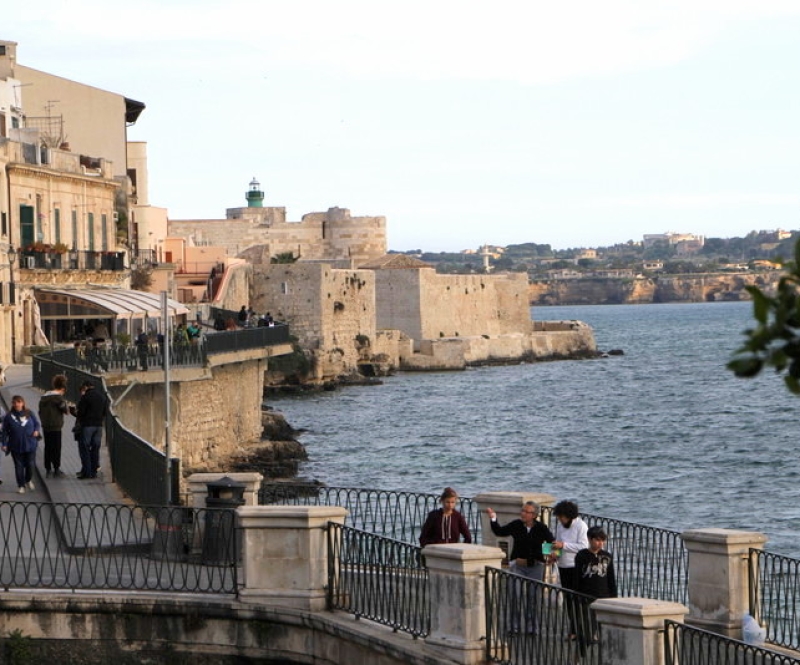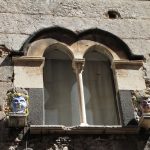Chambers Architects: Ortigia Island, Siracusa, Sicily Part 1 of 4
Eastern view of the rooftops on Ortigia Island, Siracusa, from the balcony bar at the Des Etrangers Hotel
If Greek temples, Roman villas, aqueducts, Norman cathedrals, and Baroque churches appeal to you, Sicily offers a range of historic architecture unmatched in the Mediterranean. For our initial exploration of the island off the toe tip of Italy’s boot, Siracusa (Syracuse), a UNESCO World Heritage Site, was our base for eight days. We found a hotel on Ortigia, the island that is the historical center of Siracusa known as Città Vecchia (the Old City). It contains many of the historical landmarks we wanted to study and photograph for our Texas architecture firm.
When we left Dallas, we were confident in our ability to deal with the capriciousness of Italian roadways. Getting to the island, however, proved a greater challenge than we imagined. We picked up a rental car in Catania, after an overnight flight from DFW to Frankfurt. Armed with our Michelin spiral-bound road map, we were a pretty fair match for the aggressive Sicilian drivers, and though we knew Ortigia was “over there,” we couldn’t find the narrow bridge that connected Siracusa to the main island. Two-lane highways became alleys, leading us so close to people dining under umbrella tables that we could have plucked the sardines and blood oranges from their plates. “This can’t be a street,” we said. “Surely, we’re not supposed to be driving on sidewalks.”
Lost and no closer to the island, we stopped at an Esso benzina station to ask for directions with our italiano bruto supplemented by hysterical sign language. The men seated near the door read the panic on our faces and summoned a woman from inside to speak with us. She looked at the point on the map we were trying to find and warned, “You will never find this place. I take you there.” Not wishing to impose, we declined, “No, no, signora, dice per favore.” Our awkward, but apparently understood request, brought a strong response from la signora. “No tell you, I will drive my auto. You follow.” We relented and she led us on a break-neck ride through the streets of Siracusa, across the bridge to Ortigia, through a tiny arch, hugging a wall built by early inhabitants. She screeched to a stop and pointed to the door of our hotel. Rushing to her car window, we tried to thank her with a ten-Euro bill. She pushed it away and exclaimed, “Welcome to Siracusa. You are our guests.” She grabbed us for a three-kiss hug, which we gladly returned. We were family that day and embraced by our delighted island hosts for the remainder of the trip.
At the desk of Des Etrangers Hotel a hearty “Buongiorno, you are the Chambers, non?” greeted us. “Si,” we answered, showed our passports, and filled out paperwork on our tiny car, a Renault Scenic, to be held at a remote place until we called for it. It wasn’t until the fifth day that we realized “la beeg Sha-nique-kwa,” (big Scenic) meant our car had arrived at the hotel from the parking lot.
Colonized by the Corinthians around 734 B.C., Siracusa and its ancient historic center of Ortigia, embodies all of antiquities of the ancient Mediterranean, rivaled only by Athens, Carthage and Rome. It was a feast of ancient history in architecture, monuments, geography, geology and archeology. It brought us the closest we’d ever been to understanding how figures in history lived in the monuments and sights of an ancient world.
Ortigia Island’s labyrinth of ancient and medieval streets made for an exciting classroom of Greek, Roman, Moorish, Byzantine and Judaic civilization. Physical evidence of these cultures solidly intact, Ortigia is a fascinating destination for anyone curious about the historic patrimony inherited from classical mythology, early Christianity, and medieval Judaism.
The Sanguinello blood orange, a locally abundant fruit brought to Sicily by Arabs, is the best metaphor for this jewel in the Ionian Sea. Like its people, the fruit features a soft maroon skin, very few bothersome seeds, and a sweet and passionate center. The distinctive Sicilian “full-blood” citrus has multiple vibrant blood-colored streaks in its flesh. It only develops when temperatures are low at night and warm during the day–an exotic treat for intrepid explorers.
Photography by Stephanie Chambers, unless otherwise attributed
Sicilian Fennel, Blood Orange Salad with Green Onion and Mint
Makes 4 servings
Olive oil, blended with the juice from the oranges, creates refreshing vinaigrette. Market tip: Fennel bulbs should be heavy for their size — this indicates plenty of moisture — and have a smooth outer layer.
2 blood or navel oranges
1 large fennel bulb, halved lengthwise, cored, very thinly sliced crosswise
5 sliced green onion tops
8 small fresh mint leaves, torn in half
3 tablespoons extra-virgin olive oil
20 oil-cured black olives
Cut peel and pith from oranges. Cut between membranes to release segments. Toss orange segments, fennel, onion, mint, and oil in large bowl to coat. Season the salad with salt and pepper. Transfer salad to platter. Garnish with olives and serve immediately.
Video of the Ortigia fresh market and photographic gallery of Ortigia streets and architecture by Stephanie and Steve Chambers.
TWO EUROS FOR A KILO OF STRAWBERRIES! VIDEO









